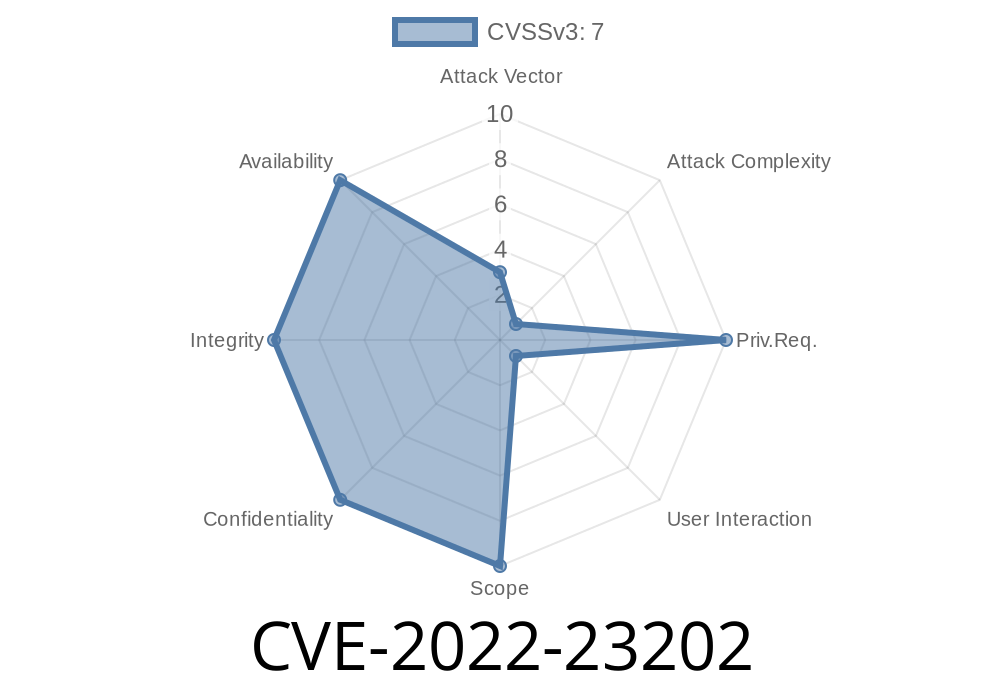Computer Emergency Response Team (CERT) has recently issued a security advisory regarding a vulnerability in Adobe Creative Cloud Desktop versions 2.7..13 and earlier. This blog post aims to explain the details of this vulnerability, how it can be exploited, and what precautions and solutions users can take to protect their systems against potential attacks.
CVE-2022-23202 Background
The vulnerability, dubbed as CVE-2022-23202, allows an attacker to execute arbitrary code on affected systems due to an Uncontrolled Search Path Element vulnerability. What this essentially means is that, during the installation process, the Adobe Creative Cloud Desktop application has a security flaw that can potentially allow attackers to insert and execute malicious Dynamic Link Library (DLL) files, giving them unauthorized access to the user's system.
Exploit Details
It is important to emphasize that exploiting this security flaw is not a simple task and requires the attacker to perform multiple steps and user interaction to successfully execute malicious code. The key steps involved are:
Downloading a malicious DLL file
The attacker must create a malicious DLL file that contains the code they intend to execute on the target system.
Co-hosting the malicious DLL file with the Adobe installer
To exploit the vulnerability, the malicious DLL file must be hosted in the same folder as the Adobe Creative Cloud Desktop installer.
Victim interaction
The attacker must convince the victim to download and execute the Adobe Creative Cloud installer from the maliciously modified source containing the malicious DLL file.
Given the need for user interaction, the complexity, and several factors beyond the attacker's control, this attack vector is classified as high complexity.
Code Snippet
The following is an example of a malicious DLL file that an attacker might use to exploit this vulnerability:
#include <Windows.h>
// DLL entry point
BOOL APIENTRY DllMain(HMODULE hModule, DWORD ul_reason_for_call, LPVOID lpReserved)
{
if (ul_reason_for_call == DLL_PROCESS_ATTACH)
{
MessageBox(NULL, L"Malicious code executed!", L"Warning", MB_ICONWARNING);
}
return TRUE;
}
The following links provide further information about this vulnerability
1. CERT Security Advisory
2. Adobe Security Bulletin
3. CVE-2022-23202 Details
Mitigation and Precautions
While this attack vector may be considered complex, it is essential to ensure that systems are protected against any potential exploitation attempts. Users are advised to:
Update to the latest version of Adobe Creative Cloud Desktop
Adobe has released an update to address the vulnerability. Users should make sure they are running the latest version of the software, available through the official Adobe website or the application auto-update feature.
Verify the source of downloaded software
Always validate the source of any software you are installing. Ensure that you download software only from official websites and trusted sources.
Use security software
Install and keep antivirus/antimalware software up to date to ensure an additional layer of protection against any potential security threats.
Conclusion
CVE-2022-23202, an Uncontrolled Search Path Element vulnerability in the Adobe Creative Cloud Desktop, presents a high complexity attack vector that requires user interaction and careful planning on the attacker's part to exploit successfully. Staying up-to-date with the latest software versions, verifying the source of downloads, and using security software are effective precautionary measures to keep systems secure against such vulnerabilities.
Timeline
Published on: 02/16/2022 17:15:00 UTC
Last modified on: 02/24/2022 16:05:00 UTC
